JACKSON – Catholic Day at the Capitol is set for Wednesday, February 4. This fifth annual event, sponsored by the Jackson and Biloxi Dioceses, brings social justice issues to the forefront of Mississippi legislators through the lens of Catholic social teaching.
The Catholic Charities Poverty Task Force is already engaged in thorough research and prayerful reflection to determine which issues are most pressing for the 2015 session and beyond.
Make plans to join Catholics from all across the state of Mississippi on February 4, to hear social justice speakers; attend Mass concelebrated by Bishop Joseph Kopacz of the Diocese of Jackson and Bishop Roger Morin of the Diocese of Biloxi; meet with state representatives and tour the capitol building.
Event details and registration information will be available soon. Those who wish to get involved now can contact the Catholic Charities office of Parish Social Ministry, 601-383-3849
Category Archives: Diocesan News
Respect Life theme calls for daily conversion, action
 By Maureen Smith
By Maureen Smith
October is observed in the church as Respect Life Month, a time to focus on issues of life and human dignity, including the death penalty, abortion, euthanasia and respect and care for the disabled. The United States Conference of Catholic Bishops (USCCB) has posted prayers, artwork and activities on its website to help parishes and individuals celebrate this month.
Cardinal Sean O’Malley, OFM Cap., the chairman for the USCCB Committee on Pro-Life Activities, wrote a statement about this year’s theme, “Each of us is a masterpiece of God’s creation,” in which he explains how our everyday actions can have a profound impact on this issue.
The theme comes from Pope Francis’ 2013 Respect Life Day statement when he said, “even the weakest and most vulnerable, the sick, the old, the unborn and the poor, are masterpieces of God’s creation, made in his own image, destined to live forever, and deserving of the utmost reverence and respect.”
Cardinal O’Malley writes about how Pope Francis has lived out this statement in his care for the poor, the marginalized, the elderly and those who are ill. He writes that we are all called to this kind of life. “Our mission is to show each person the love of Christ. As uniquely created individuals, we each have unique gifts which we are called to use to share Christ’s love. We are continually given opportunities to do so in our interactions with the cashier at the grocery store, our spouses, children, friends and even the people we encounter in traffic. Each of these moments is valuable beyond our realization. We may never know how much a simple gesture of compassion may affect someone’s life,” writes the cardinal.
He wrote about how people in modern society are isolated and often feel like abortion or suicide is their only choice. “The Church’s antidote to an individualism which threatens the respect for human dignity is community and solidarity,” wrote Cardinal O’Malley.
Locally, Catholics are invited to participate in “40 Days for Life,” an ecumenical program of prayer, fasting and advocacy to end abortion. The campaign kicks off with a rally outside Mississippi’s only remaining abortion clinic on State Street in Jackson on Wednesday, Sept. 24, at noon. People can then sign up for shifts to stand outside the clinic in prayer.
All participants must sign a pledge to be peaceful and to treat everyone, including clinic workers and supporters, with respect. Volunteers can sign up online at 40daysforlife.com. Search for the Mississippi event.
Teenagers can also sign up for the January March for Life in Washington. The deadline to register on www.jacksonmarchforlife.com is Oct. 17.
“Love and justice must motivate each of us to work for a transformation of our own hearts so that we can transform the world around us. This is the message of Pope Francis. May the Risen Lord put the Gospel of joy into our hearts so that we may bear witness to the greatest love story ever told,” concludes Cardinal O’Malley’s letter. The full text of the letter is available at www.usccb.org in the Respect Life section of the website.
Ice bucket challenge raises bioethics concern
By Maureen Smith
Schools, coaches, sports teams, pastors, it seems like almost everyone is taking part in the ‘ice bucket challenge this summer including Madison St. Joseph School principal Keith Barnes, Father Scott Thomas, pastor of Clarksdale St. Elizabeth and Immaculate Conception parishes, the campus ministry teams at both The University of Mississippi and Mississippi State University, but they all did it with an eye on Catholic moral teaching. Catholic leaders are asking the faithful to think carefully before they join in the now ubiquitous campaign.
As of Aug. 26, the ALS Association (ALSA) had received $88.5 million in donations from July 29-Aug. 26. The challenge itself, choosing between being doused with ice water and donating to research for a cure for amyotrophic lateral sclerosis (ALS), is not a problem. Selecting the organization receiving the donation may pose an issue.
According to the National Catholic Bioethics Center, some organizations, including the ALSA, support embryonic stem cell research. The center sent out a statement supporting the idea of raising awareness, but also urging Catholics to direct their donations to organizations that use adult stem cells or simply serve those suffering from ALS, also known as Lou Gherig’s disease.
The Catholic Church opposes any research involving the destruction of human embryos to create stem cells. Adult stem cells, so called because they are derived from living human beings, also have promising scientific value but do not require destruction of an embryo. The reprogrammed stem cells can sometimes be used to replace damaged cells.
Carrie Munk, a spokeswoman for the ALS Association, told Catholic News Service that the organization primarily funds adult stem cell research and is at the end of funding one single embryonic study, which is funded by one specific donor.
She said that if someone “is uncomfortable with any type of research we do, they can restrict their gift” stipulating that it not be used in the embryonic stem study or any stem cell research.
Father Thomas posted an article about stem cell research and a list of acceptable donation sites on Facebook along with the video of his challenge. St. Dominic Hospital sent a message out to its staff educating them about the issue and instructing them not to promote organizations using embryonic stem cell research.
The issue has caused concern in Catholic communities across the nation. Some dioceses have issued statements urging schools that participate to send donations to other research organizations, such as the John Paul II Medical Research Institute in Iowa City, Iowa, which does not use embryonic stem cells in its research. That’s where the group in Starkville directed its donation.
An Aug. 20 statement from the Archdiocese of St. Louis points out: “There is nothing immoral about raising awareness for diseases and ethical research towards curing diseases; there is no reason Catholics can’t participate in the ice bucket challenge. The key, however, is to ensure that donations from participation are being utilized to support morally licit research.”
Similarly, New Orleans Archbishop Gregory M. Aymond told archdiocesan priests and employees in an Aug. 13 email that it’s “possible to participate in the ice bucket challenge and to do so in a way that is morally acceptable.”
“We have received questions on this project. Many people do not realize that some of the research is done with embryonic stem cells, which is against our pro-life stance,” he wrote.
He noted that many people in the New Orleans archdiocese suffer from ALS, including Jesuit Father Ray Fitzgerald, former principal of Jesuit High School New Orleans, who announced he was stepping down last year because he had been diagnosed with ALS; and Steve Gleason, a former football player with the New Orleans Saints, who was diagnosed with ALS and is an active advocate for ALS patients.
Some alternative organizations to consider:
The Cell Therapy Foundation, which specifically promotes adult stem cell research. On their website, it is possible to donate in a directed way to specific research, including ALS: https://www.celltherapyfoundation.org/Donate-Now/Funding-Specific-Research.
Compassionate Care ALS, which offers much-needed care and treatment for people living with ALS (instead of focusing on scientific research and the development of therapies): https://www.ccals.org/home.php.
The John Paul II Medical Research Institute, a secular medical research facility committed to maintaining and promoting pro-life practices: https://www.jp2mri.org/
GermanFest celebrates music, culture, faith
GLUCKSTADT – GermanFest has been a tradition of St. Joseph Parish for the last 28 years. This year the festival is set for Sunday, Sept. 28, from 11 a.m. – 5 p.m. on the church grounds. As always, admission and parking are free.
The Gluckstadt community was founded in 1905 by families of German descent. Many of their descendants still live in the area and play an active role in putting on this festival.
The family-oriented event is best known for its German food and folk music provided by the bands, Die Mitternaechters and MS Schwingen.
Sizzling shish kabobs, bratwurst slathered in sauerkraut, and authentic German desserts, pies and other home-made favorites will be served. The menu also includes giant fresh oven-baked pretzels, hot dogs, and rippchenkraut (pork chops smothered in homemade sauerkraut). Dark and light beer will be on tap, along with sodas and bottled water. Again this year there will be a German wine tasting booth.
Meal tickets are $5 in advance and $6 on the day of the festival. Advance meal tickets are available from parishioners or by calling the parish office, 601-856-2054.
Kids activities include the ever-so-popular hamster pool ball, as well as the rock-wall, and an assortment of children’s games.
Commemorative German items, T-shirts, homemade breads, authentic German desserts, homemade jellies, spreads, canned goods as well as sauerkraut lovingly made by teams of parishioners will also be available for purchase.
Festival goers may wish to bring a lawn chair, but coolers, solicitors and pets are not allowed on the grounds.
For more information, call Pam Minninger, 601-856-2054, or visit www.stjosephgluckstadt.com.
Former refugee wins international peace prize
JACKSON — If Bul Mabil is anything, it’s resilient.
He was five when he and his brother fled civil war in his home country of Sudan. The boys walked to Ethiopia where they lived in a refugee camp until another conflict drove them to Kenya.
After many years he was joyfully reunited with his mother — only to discover he had been selected for resettlement in America as one of the Lost Boys of Sudan.
Fourteen years later the soft-spoken 31-year-old is starting a new adventure in yet another country with hopes of having a positive impact on the lives of other refugees. Mabil is one of only 50 people worldwide to be selected for a Rotary Peace Fellowship to pursue a master’s of Conflict, Security and Development at the University of Bradford in the United Kingdom.
In 2000, Mabil came into the care of the Catholic Charities’ Unaccompanied Refugee Minor Program (URM). The program works with the U.S. State Department and the U.S. Conference of Catholic Bishops (USCCB) and has been assisting refugees since the 1980s. The history of the URM program reads like a history of disaster and conflict around the globe. Waves of refugees have come from Vietnam followed by Haitians, Liberians, Congolese, Burmese, Sudanese, Eritreans and more. Program director Dr. Debra West said the most recent clients hail from countries in Central America including Guatamala and El Salvador who came in through the 2008 Human Trafficking Act.
“Most of them are fleeing war,” explained Greg Patin, executive director of Catholic Charities. “Some are victims of religious persecution or ethnic persecution and we have had some who were victims of human trafficking, particularly sex trafficking,” he added.
All the clients in the program must apply for entry into the U.S. in their home countries. They are screened and only those eligible for refugee status can join. West said the Jackson program has helped 500-600 kids start new lives in America.
Clients must not yet be 18 and will be emancipated when 21-years-old. Younger children live with foster families, older ones live in a group home or in independent living situations. Everyone is screened for mental and physical wellness and URM therapists and cultural specialists supervise their assimilation and provide therapy as needed. Everyone gets vaccinations and case workers make sure they are placed in schools at the appropriate grade level. “Everyone is mandated to be in some academic setting,” said West. The kids get academic help from tutors provided by the URM office.
Mabil holds a BA in political science and a master’s of Public Administration. On the same day after college he was offered two jobs. One was a lucrative position as a financial analyst. The other was a job as a case manager for the victims of Hurricane Katrina. He opted to help people on the coast.
“I took this job because of what was done to me. I was brought to this country and given an opportunity. I decided I will give back to others,” he explained.
His next job was as an advocate for children with mental and physical disabilities for the Mississippi Department of Public Health.
Mabil’s most recent position was at the Department of Transportation as a Principal Transit Specialist helping people without cars find transportation. “When I go back to the coast, I can see the difference I made, a house I helped build or people I helped. When I go back to the health department, I can see the difference I made,” he said.
He and his wife also fostered a pair of refugees who came through the URM program. The first was from Haiti.
“We were not interested in fostering. My wife had just given birth to our daughter, but then the earthquake happened. That broke our heart,” he explained.
“Then Catholic Charities called and said they had a young lady from Haiti who needed a foster family. It was a way we could help Haiti,” he said. The family later fostered a young woman from Congo.
A member of his church, St. Andrew’s Episcopal, told him about the Rotary award.
“This is a chance to make a difference globally, not just locally,” he said. “This program is to train young leaders who can be catalysts for peace and conflict resolution nationally and internationally,” he added.
There is no doubt his own history with the URM program played into his decision to take on the fellowship. “The value of this program is that they are able to help children have an opportunity here in the U.S. Wherever they come from – there was a reason they came. They did not just decide to go,” he said. “None of us (the Lost Boys) wanted to leave the country where we were born. We had to leave because of war,” he said.
Patin said the work of the URM program has its roots in the gospel itself. “Jesus and his family were refugees. We are following that tradition in reaching out to these children,” Patin said.
“Refugee issues have become big issues nowadays. The situations affecting these people are not well understood. I would like to highlight them,” Mabil said. “It is different coming from a war-torn country. These things (his success) did not come easily. It took struggle and I would not have overcome the struggles without a program like URM,” he said.
Mabil is a naturalized American citizen and hopes to come back with his new degree in a little more than a year. He would like eventually to work for the State Department or some other national agency.
Vacation from work, not from Mass
BY ELSA BAUGHMAN
At a recent Sunday Mass in Crawley, England, where I was vacationing, I heard the priest say something during his homily that I have known and has affected me and many others for a long time. He said it is natural to desire to hear the word of God in our own language.
In his homily, Msgr. Tony Barry, pastor of St. Francis and St. Anthony Church (The Friary) in Crawley, said the last time he had heard the Gospel of that Sunday, the Eighteenth Sunday in Ordinary Time, it was read in French while he was visiting France. “It was not the same as if I would have heard it in English,” he said to the congregation.
Msgr. Barry reflected on Pope Francis’ words on the homily in the Holy Father’s recent Apostolic Exhortation, “Evangelii Gaudium.” Msgr. Barry quoted from paragraph 139: “Christian preaching thus finds in the heart of people and their culture a source of living water, which helps the preacher to know what must be said and how to say it. Just as all of us like to be spoken to in our mother tongue, so too in the faith we like to be spoken to in our “mother culture,” our native language (cf. 2 Macc 7:21, 27), and our heart is better disposed to listen. This language is a kind of music which inspires encouragement, strength and enthusiasm.”
These words made my heart burn because there was a time in my life when I went to Mass but I could understand very little of what was said. That was in 1976 when I came to the United States to attend school at the University of Southern Mississippi.
Going to Mass has always been very important to me but during that time I usually felt that something was missing because I couldn’t understand was what said during the homily and in other parts of the celebration. I continued going to church every Sunday nonetheless and as time passed I could understand better but my desire to be able to attend the liturgy in my native language has never diminish.
The Diocese of Jackson has made a great effort to serve the Spanish-speaking Catholics who have made Mississippi their home. In 1974, Msgr. Michael Flannery, present pastor of Madison St. Francis of Assisi Parish, began to celebrate Mass in Spanish in Rosedale, Cleveland, Aligator, Hill House and Shelby for the few Hispanics migrants living in the Delta.
By Christmas of 1979 a Mass in Spanish began to be celebrated in the Cathedral of St. Peter the Apostle in Jackson every Sunday. That Mass continues to be celebrated every Sunday at 2 p.m.
As the Hispanic population increased in the diocese other communities began celebrating Mass in Spanish. Presently there are 23 parishes and missions celebrating Mass in Spanish and three have bilingual services. Also, to keep the faith alive among those who can’t read English, since 1997 the diocese started publishing a four-page insert in Spanish in Mississippi Catholic which now runs once a month.
The diocesan office of Hispanic Ministry is very active and offers workshops in Liturgy, leadership and a School of Ministry. So, I can say with certainty that our diocese has been doing what Pope Frances preaches in his “Evangelii Gaudium.”
As all practicing Catholics should, finding Mass on Sunday while travelling is challenging but necessary. So, being in England and Ireland with two friends and fellow St. Therese parishioners, Teresa Preuss and Esperanza Velasquez, we starting looking for a church to attend.
Searching on her iPad, Teresa found a church very near the hotel where we were staying in Crawley, a city 28 miles south of London. The church, St. Francis and St. Anthony, was across from a restaurant where we had eaten several times but had not realized it was a Catholic church!
It is a special experience to attend Mass in a different country and it is even more special when we are invited to serve in it. Esperanza was asked to bring the gifts to the altar during the offertory at the 11:30 a.m. Mass.
The church, as in many churches in Europe, has two small chapels inside where people gather before and after Mass to pray and to light candles.
We had a peculiar experience the following Sunday while we were standing outside the Dublin, Ireland, airport looking for a shuttle bus to take us to a hotel. Suddenly, we heard bells ringing. We wondered from where the sound of the bells’ ringing was coming. We walked around the building and there it was, a Catholic church, Our Lady Queen of Heaven – outside the airport! It was just a one-minute walk from the arrivals terminal near the parking garage.
It was 11 a.m. and Mass was just starting. We walked in with suitcases in hand and sat down in the back of the church to worship our Lord, one who is very much in hand when we need comfort and when we need to fulfill our Sunday obligation.
Curious about how their bulletins might look, I found out they are just like many in our diocese, with information about parish life and events. The bulletin of Our Lady Queen of Heaven Church in Dublin, “The Peoples Mass,” includes the Introduction of the Rites and the Liturgy of the World.
We also toured St. Paul’s Cathedral in London, the Anglican cathedral of the Diocese of London; and in Dublin we visited St. Patrick Cathedral, the National Cathedral of the Church of Ireland, a church of the Anglican communion. Its present building dates back to 1220 and was originally the Catholic cathedral.
At all these places of worship I prayed for three specific matters: for peace in the world, for the well being of my family and friends and for all the people of the Diocese of Jackson. There is a saying that when one visits a church for first time prayers for three specific intentions may be offered and God might grant them. I hope God heard my prayers!
Columbus Annunciation celebrates newly restored historic church
By Mary Woodward
COLUMBUS – Annunciation Parish realized a long-awaited dream on the Solemnity of the Assumption as they gathered for Mass with Bishop Joseph Kopacz on the Holy Day in the new church and then after the Mass made their way over to the original church to bless the historic restorations completed this summer. Father Robert Dore, pastor, was extremely pleased with the large turnout of parishioners and friends for the celebration.
The cornerstone for the original church was set in 1863 but construction was delayed another decade due to the Civil War and Reconstruction. Father Jean Baptiste Mouton, a French priest who was trained in architecture, designed the original church in Gothic style.
Father Mouton served the church in many places in the early days of the diocese. At one time he covered most of East Central and Northeast Mississippi serving developing Catholic communities from Meridian to Corinth. A chaplain during the war, he ultimately died of Yellow Fever during the 1878 epidemic.
The parish has been researching and planning the historic restorations for almost 10 years. The desire to capture much of its original decorative scheme and preserve its Jacoby stained glass windows fueled efforts to have the church declared a historic building on the National Register.
Parishioners poured over old documents and photographs of the interior of the church in order to preserve the design as closely as possible to the early decorative scheme. Conrad Schmitt Studios in New Berlin, Wisc., implemented the design under lead artist Will Kolstad, who has worked on other projects in the diocese at Jackson St. Peter Cathedral in and Natchez St. Mary Basilica in Natchez.
For the blessing, a standing room only congregation rejoiced in the culmination of years of hard work including no small amount of blood, sweat and tears and plenty of sacrifice.
One special moment for long-time parishioner Frank Troskey was to see the altar cloth his mother, Elizabeth, had made in 1942, adorn the original altar of the church. He said his mother would work on the cloth after dinner each night for several hours until it was completed.
The newly restored church will now be used as a daily Mass chapel, weddings and other special celebrations. A lift has been incorporated into the side of the building near the front steps for those who have trouble with stairs to enter the church.
Anyone wishing to help support the restoration of this historic Catholic house of worship may send a donation to: Annunciation Catholic Church, 823 College Street, Columbus, MS 39701
Principals participate in international collaboration
By Laura Grisham
Principals Bridget Martin of Southaven Sacred Heart and Clara Isom of Holly Springs Holy Family schools attended the third International Meeting of Dehonian Educators (IMDE) July 21-25 in Valencia, Spain, on behalf
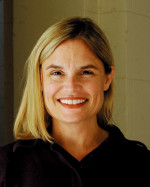
Martin
of International Meeting of Dehonian Educators (SHSM), which supports those schools. ESIC, a multi-campus business school operated by the Spanish Province of the Sacred Heart Brothers and Fathers (SCJ), hosted the weeklong gathering.
Education is a priority of the SCJs , translated from the hopes their founder, Father Leo John Dehon, to have an impact on people and society through education.
The title given to this year’s conference was “Educare: Sint Unum.” The Latin ‘educare’ was used because of their desire to educate the whole person, and ‘sint unum’ to remind the educators that they are all a part of one project.
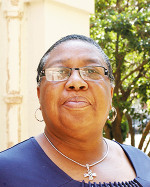
Isom
The IMDE’s objective is to network and collaborate: to get to know one another, to work on the formation of the Dehonian identity as it applies to the schools and to share resources. All of the educators at local, national and international levels spent the week discussing ideas on how to promote the ideas and a Dehonian curriculum to the students, parents and teachers in our schools.
“You gotta know your history,” said Isom. “Education was his (Father Dehon’s) focus. He sent out his people to teach to break the cycle of poverty.”
However, collaborating across continents is not so easy, not to mention the variety of educational institutions from pre-school, middle and high school, to technical schools, seminaries and universities. Each institution, though striving to teach the same charism (any gift that flows through God’s love to humans), has unique ways to accomplish the mission in their respective cultural and institutional setting. Coming together to share strengths and innovations creatively solves many problems. And that was the focus of the gathering—to draw from one another’s strengths and shared identity.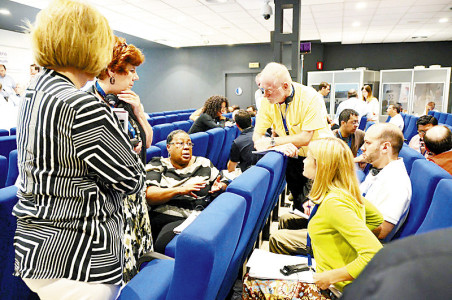
The master plan drawn up to achieve the conference objectives gives a communications hierarchy to educators on a provincial, regional, district and school level. Using technology and the web in particular, all will interact and be able to share in the ideas, projects and events to come. All educators and students will have access to this site.
The principals plan to incorporate more activities at the schools surrounding the Catholic Dehonian ideas and traditions. Each school hopes to effectively be drawn towards the larger common goal.
One way that the US Provincial group suggested coming together was to emphasize feast days for their respective schools — St. Martin, Our Lady of Guadalupe, the Holy Family, the Sacred Heart and St. Joseph. Retreats, in-services, combined school events and a host of other things are in the planning stages.
(Reprinted with permission from “… from the Heart,” the newsletter for SHSM.)
Schools welcome students, improvements
By Maureen Smith
Almost 4,000 students flooded hallways once again at the 13 Catholic schools across the diocese during the second week of August. Many schools are embracing the theme of “joy” in one way or another thanks to the work of the Office of Education, Pope Francis and Bishop Joseph Kopacz.
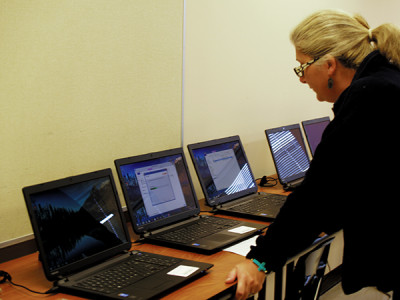
MADISON — Mary Ann Bourn, technology coordinator at St. Joseph School installs software on to laptops in the school’s new STEM lab. (Photo by Maureen Smith)
The bishop distributed copies of the Pope’s apostolic exhortation “Evangelii Gaudium,” or the Joy of the Gospel, to department heads at the chancery and has included discussions about it in regular meetings.
“We have quarterly sessions at each school focused on Catholic identity at our schools. This year, thanks to the leadership of the bishop, we decided to focus on Evangelii Gaudium in those sessions,” explained Catherine Cook, superintendent of Catholic Schools for the diocese.
The diocese saw increases in enrollment at several schools, including a 25-student jump in Southaven, while other schools added facilities to make room for new students and programs. Here is a look at improvements, additions and expansions across the diocese:
Thanks to five years of steady increases in enrollment, Columbus Annunciation opened the doors to a new middle school building housing classrooms, a new computer lab and offices to be used for tutoring and speech therapy.
“Having this new, large space dedicated solely to our middle school students will allow us to better accommodate their specific educational and social needs,” said Annunciation principal Joni House.
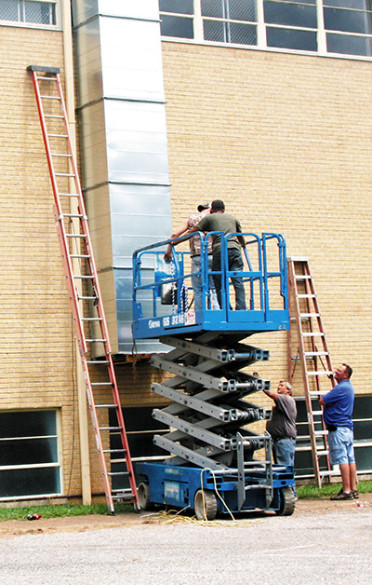
HOLLY SPRINGS — Workers install air conditioning equipment in the gym at Holy Family school. (Photo by Laura Grisham)
Natchez Cathedral School dedicated a new middle school building Friday, August 15, the Feast of the Assumption. The facility was the second of a three-phase capital campaign for the school.
“Most of our time this summer has revolved around the new middle school building, so I think everyone is just excited to see that finally done and ready to go,” said Pat Sanguinetti, principal for the high school. The new building has eight classrooms and a science lab. The school has seen enough enrollment increases this year to create a waiting list. “That speaks highly of our school and the staff,” added Sanguinetti. Air conditioning is being added to the gym at Holly Springs Holy Family. “We just thank God, Sacred Heart Southern Missions, our families, our sponsors, and members of the community who rallied around us to get this done,” said Clara Isom, principal. This will also allow the school to host gatherings earlier in the year. Previously, the administration had to wait until cooler weather to hold family meetings for the whole school.
A second improvement at Holy Family is the addition of two Promethian boards so now every classroom has one. Promethean boards are interactive boards that allow teachers and students to access the internet, participate in online learning and group quizzes and more. Finally, seventh and eighth graders will have art classes at Holy Family this year.
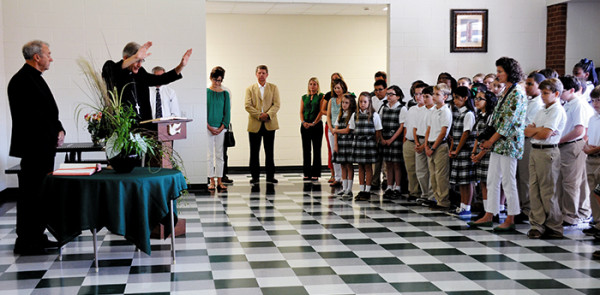
NATCHEZ — Bishop Joseph Kopacz, center, offers a prayer of blessing at the new Cathedral Middle School facility. Pastor David O’Connor took the bishop on a tour as part of the celebration. (Photo submitted by Regina Mardis)
Madison St. Anthony added a science, technology, religion, engineering, art and mathematics lab (STREAM) inside an existing art lab. The school also welcomes new principal Julie Bordelon for the year.
Clarksdale St. Elizabeth offered a summer camp this year. Principal Jeannie Roberts said parents were thrilled. The days were themed and parents could use the camp when they needed it without having to make a season-long commitment. Students in grades three to six will add a typing skills lesson to their weekly routine this year and the school will continue the mother’s morning out program started last year.
Sister Margaret Sue Broker, OSF, takes on a new role at Southaven Sacred Heart, becoming the religious education director for the elementary school. Sister Broker has been connected to Sacred Heart for 50 years. The school also added Brother Clay Diaz, SCJ, as middle school religion teacher and transitional coach for new students and families. “One thing I really like about our school is that we represent 15 nationalities here,” said Bridget Martin, principal. “Brother Diaz is a native of Puerto Rico so he speaks Spanish fluently. He also speaks sign language and we have some hearing impaired parents so he can help us bridge communication gaps with those families. He is a great asset,” added Martin.
Madison St. Joseph added a science, technology, engineering and mathematics lab (STEM) utilizing new laptop computers, is building new seating for the baseball field and got new seating for the gymnasium.
Greenville St. Joseph has added Chromebook research stations to its STREAM curriculum. The tablets are part of “an effort to build a student-based community problem solving / critical thinking component into our STREAM classes,” said Paul Artman, principal. He added that the school is testing an initiative to give each student a dedicated tablet.
At Meridian St. Patrick work crews spent the summer transforming the old hardwired lab into a third-grade classroom and creating a mobile computer lab utilizing Chromebooks that can work in any classroom environment so it can go where the students are.
The iPad tablets are on the move at Jackson St. Richard where a cart with 20 of the devices was added so students can participate in group activities using them. Volunteer Angie Hembree spent the summer organizing a STREAM lab at St. Richard for pre-k through sixth grade students.
The St. Aloysius Student Writing Center at Vicksburg Catholic is a new resource of the English Department dedicated to supporting both students and faculty members in the pursuit of writing across the curriculum and the use of writing to develop critical thinking skills. Students in grades seven through 12 may access the center before school starts every day, where trained student partners will assist them with any writing assignment from any class.
The Writing Center will be staffed initially by senior English students who received training this summer from Dr. Alice Myatt, Associate Director of the Center for Writing and Rhetoric at the University of Mississippi.
(Editor’s note: see related Back to School material on pages 8,9 and 15.)
Assistance rules revised after public comment on drug testing
JACKSON – Children’s rights advocates are applauding a revision in the rules governing Mississippi’s Temporary Assistance for Needy Families (TANF) program. During the last legislative session, lawmakers passed a provision which would force some people who apply for TANF to take a drug test. A positive result would mean an end to the assistance for the whole family.
Children’s advocates argued the practice would punish children in those families and did not provide adequate resources for the parents, who would be expected to pay for the test and any ensuing treatment. The state took comments at a July 22 public hearing and the Mississippi Department of Human Services revised the rules so children will still receive assistance. The Mississippi Center for Justice, one of the organizations speaking out against the harsher drug testing rules, released a statement Aug. 5.
“We applaud DHS for adopting a provision that protects TANF payments for children. This action comes after a July 22 public hearing that we called for and that featured heartfelt testimony calling for the change to protect payments for children, among other things. While we are generally very pleased with the new regulations, we continue to express concern about the viability of the chosen screening instrument, and reassert that TANF recipients should not be required to pay for the treatment process,” the statement said.
Other critics of the law, including the Mississippi Economic Policy Center, argue that drug testing, especially when the person knows the date of the test, is inefficient and ineffective and that recipients are already screened by a case worker who should be able to identify and address any substance abuse problems. The revised rules went into effect Aug. 1.







